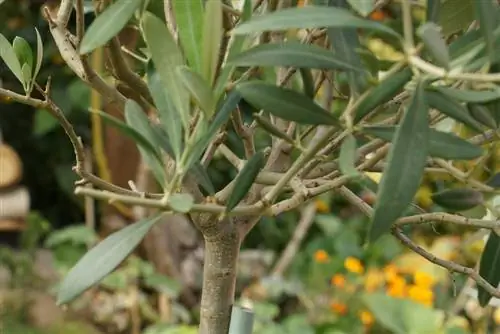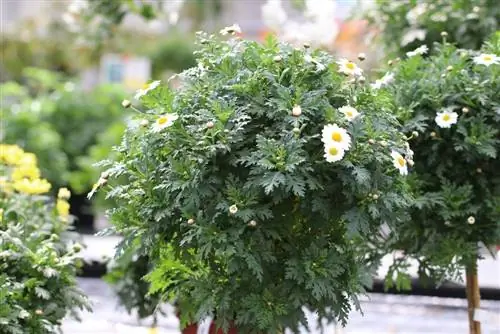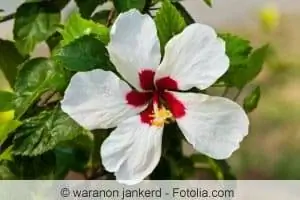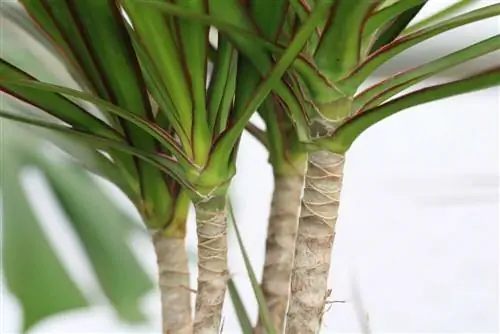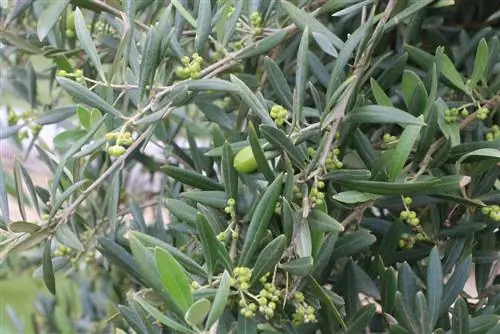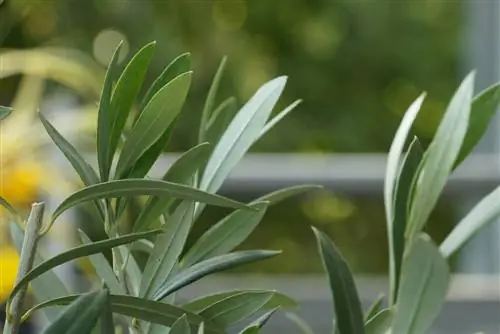- Author admin [email protected].
- Public 2023-12-17 03:39.
- Last modified 2025-01-24 12:45.
An olive trunk is very robust and requires little care. You can find out here what you should know and pay attention to.
Profile
German names: olive trunk, olive tree standard
Botanical name: Olea europea
Family: Oleaceae
Origin: Mediterranean, Middle East, South Africa
Growth height: not fixed, on average about 100-200 cm
Flower color: different (e.g. white, yellow, pink)
Flowering period: April-June
Location: full sun, warm, protected from wind and rain
Soil: moist but not wet
Other: not hardy, potentially perennial, lime-tolerant
Basic Notes
Even if the olive tree is botanically considered a real Olea europea (olive tree): in practical terms, the standard olive tree tree only has a limited connection to its “big brother”. Of course, some people ask themselves the (legitimate) question of why you can buy olive trunks at all?!
The Answer
Olive trees are trendy, but in the “real” version they can only be grown very slowly. The situation is different with the plant's standard stem: it grows extremely quickly. What initially sounds like an advantage is actually rather disadvantageous for the tribe and the owner - and these are the parties that are logically important to us.
The olive tree standard does not thrive naturally.
Here is an overview of the (un)typical characteristics:
An olive trunk can be pulled up quickly.
That's exactly what is done: you only cut off the rapidly growing initial shoot when it has reached an impressive height.
For comparison
When growing an olive tree, you usually pay attention to good branching of strong main branches.
The high-seated branches, which are formed into a dense crown, also contribute to the atypical structure.
Caution
Such narrow crowns promote, among other things, fungal infestation. Plant lice also feel right at home in the thicket.
When the stem grows quickly, the quality of the root system usually falls by the wayside.
An olive tree would never grow in such a shape voluntarily. And it should be noted once again that the unnatural structure tends to harm it.
Tip:
Anyone who wants to grow old with their olive tree is usually not doing themselves any favors with an olive trunk. Rather, the lengthy but considerably more natural route should then be taken with a truly genuine Olea europea.
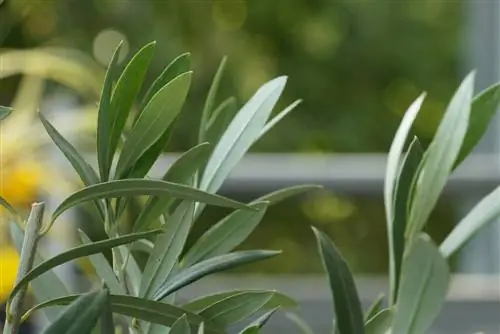
The following details are often added to the problem of selling olive tree trunks:
- The olive tree is planted in a (too) small pot.
- The pot contains poor quality, overwatered or completely dried out soil.
- The plant “lives” in a warehouse unsuitable for plants until it is sold.
For this reason, we advise anyone who decides to purchase an olive trunk to first repot the plant after transporting it home - in real garden soil with sand. This is the gentlest solution and gives the plant the opportunity to recover from the stresses placed on it.
Many people buy a standard olive tree trunk with the aim of harvesting olives. And in fact, the stems are often refined in such a way that they bear fruit comparatively quickly. However, whether the olives taste good depends on two conditions:
- Is there a second olive nearby? Cross-pollination optimizes the quality of the fruit (even with a self-pollinator)!
- Is additional lighting available? In our climate, olives can only ripen in good, intense light!
Tip:
Modern LED plant lighting is completely efficient (cost-effective and effective).
Note
Of course, there is no guarantee that fruit will form in this country. The summers in our latitudes are usually not long enough to support the ripening of the olives. That's why the olive trunk, like the real olive tree, is often cultivated "only" as an ornamental plant.
Anyone who decides to grow an olive trunk must keep in mind that the standard tree can be cultivated in a bucket WITHOUT EXCEPTION. Planting in the garden is not possible.
The care largely corresponds to the measures that also apply to the real olive tree. However, the focus is on regular cutting and generally very vigilant and careful care of the plant. Below we describe all the important tasks for cultivating the olive trunk.
Location
The olive tree and therefore also the trunk are native to the Mediterranean region, where sun and warmth are the order of the day. It is therefore important to provide the standard tree with these or at least similar conditions in its new home. If the location is not right, the plant cannot develop well.
Characteristics that the space for the bucket must have:
- warm
- sunny
- protected
Substrate
High-quality garden or potting soil is the best solution. It doesn't have to be particularly nutrient-dense. The most important thing is to avoid getting wet. That's why you build drainage into the pot. It allows excess water to drain away.
Here are some basic recommendations:
- Adjust the size of the planter to the size of the stem
- Do not use plant pots or coasters as additions
- Make sure the bottom layer is made of porous material
- clay, sandy and calcareous soil is ideal for the standard tree
Tip:
In the pot, the olive trunk can only develop roots to a limited extent in order to absorb moisture. Therefore, while avoiding waterlogging, it is essential to always keep the soil slightly moist.
Pouring
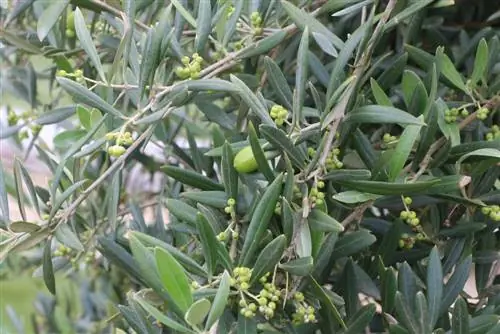
In their homeland in the areas around the Mediterranean, olive trees don't get much water. Even here they don't need too much moisture. Excessive watering is therefore not necessary and also not advisable.
Rules of thumb:
- Keep the substrate moderately moist at all times
- Pour by feel or finger test
Finger test
Put your whole finger in the ground. Before the next watering, the substrate should be dry up to the point that the finger can reach.
- If it is very hot, pour a little more
- Avoid waterlogging at all costs
Important
It is essential to ensure that no puddles form in the depressions and holes in the trunk and/or branches. Otherwise these places tend to rot.
Fertilize
The olive trunk is extremely frugal when it comes to nutrient intake. Unlike most other plants, fertilizing is not absolutely necessary. However, it doesn't do any harm either. We therefore recommend providing the olive tree standard with long-term fertilizer once a year, namely in spring.
Cutting
Cutting is pretty much the most important task in caring for the olive trunk. If the standard tree is to remain a standard tree, it must be cut regularly.
Reminder: Before being sold, the olive trunk was shaped into a shape that went against its natural growth. In order for it to keep this shape, you have to trim it carefully.
How to do it:
- Each spring, remove any branches that grow out of the round crown (restore spherical shape).
- Remove all shoots on the trunk that grow below the crown throughout the year.
- Always thin out the crown if it becomes too dense (also all year round).
Here are a few basic tips for comprehensive pruning care in spring:
- Don't be squeamish. The lush pruning in spring has no influence on the flowering, so it does not harm it.
- Cut the stem free at the bottom, as the lower shoots “draw in” a lot of juice, which costs the plant immense energy.
- Cut out everything that grows inward, otherwise the sun will have no chance to penetrate.
- Make sure that the shoots do not touch each other - they not only need sun, but also air.
- Remove branches that hang too far down.
- Only cut outwards if the stem comes too close to other plants.
- Never cut around the main shoot! Leave it and three to four main branches completely standing.
- Always first remove shoots that look sickly, grow sideways and/or are otherwise “out of line”.
Propagate
There are three ways to propagate the olive tree: sowing, cuttings and grafting. However, for the practically oriented hobby gardener, none of the variants is really satisfactory.
Sowing
Sowing is actually very easy. However, it takes an extremely long time for a tree to grow from the seeds - apart from the fact that the result is usually anything but satisfactory: not only are the harvests minimal, but many years pass before you even get there. If you still want to try it:
- You need a ripe and untreated olive.
- The pulp is removed from this olive.
- Put the olive pit 1 cm deep in potting soil.
- The vessel is covered by glass or a transparent plastic bag.
- You put the whole thing in a warm and very bright place.
- The potting soil is kept slightly moist at all times.
- Air the container regularly (otherwise there is a risk of rot due to drops of water on the glass or plastic bag).
Cuttings
Propagation from cuttings is also rarely successful. This is because the woods often do not root well.
How it works:
- Cut off young shoots that are as strong as possible.
- Place shoots in potting soil (not too deep).
- The rest corresponds to the sowing procedure.
Refining
Refining is undoubtedly the most profitable type of propagation.
Disadvantage
The method is unsuitable for laypeople.
For the sake of completeness, we would like to briefly explain the two main steps to you:
- You cut a half-woody cutting. The best time for this is in summer.
- Rooting hormones are used for rooting.
Wintering
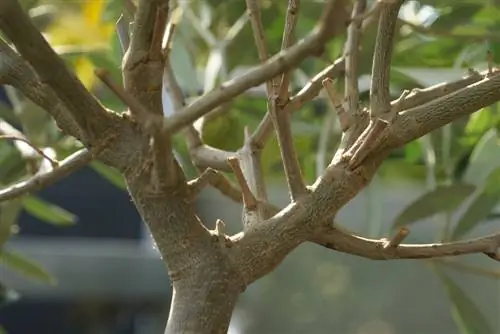
The olive trunk is of course not winter hardy. In this respect, you have to overwinter it in the house (put it away as late as possible!). Unfortunately, finding suitable accommodation is a challenge that should not be underestimated. But once a good place has been found, the further measures (including with regard to pest protection) are manageable.
- Temperatures around 10°C are ideal for overwintering the olive tree standard.
- As this is an evergreen plant, sufficient light must be ensured.
Note:
If you overwinter the olive tree in a dark place, for example in the garage, you shouldn't be surprised by leaf drop. The small tree usually sprouts reliably again in spring. However, such a gloomy wintering weakens it, which is not good in the long run.
To do:
- water little (rule of thumb: the cooler the temperatures, the less water the plant needs)
- But don’t let the bales dry out
- do not fertilize
- ventilate regularly (several times a day)
It is advisable to bring the standard olive tree outdoors again as early as possible. As the warmer days gradually take over, the stem should be slowly acclimated to the sun so that its leaves do not burn. It's best to put it in a shady place for the first week or two.
Note:
The plant can cope with sub-zero temperatures for a short time.
After all, temperatures in the Mediterranean region occasionally drop below 0°C in winter.
Diseases and pests
Olive trees and olive trunks are actually quite insensitive. They even forgive small care mistakes as long as they don't get too wet. And that brings us to the main reason for diseases: waterlogging is poison for the plant.
Here is a quick overview of the most common problems and their causes:
Root rot
Cause(s): lack of drainage and too much irrigation water
Leaf loss
Cause(s): Location in winter quarters that is too dark
Brown leaves
Cause(s): impaired water absorption (often due to too much water or frost)
Hanging Leaves
Cause(s): lack of water (less common) or incipient/progressive root rot (more common)
Tree rot
Cause(s): Cavities or holes in the plant are filled with water for an extended period of time
Spider mites
Cause(s): incorrect wintering (location too warm or air too dry)
If you take all the problems and causes together, you can see that in principle it is not all that difficult to effectively prevent diseases and pests.
Special feature
The owner of the olive trunk should be prepared for the plant to initially take a break in growth. However, this is not a reason to despair, but rather normal and even good: the temporary stop indicates that the olive tree standard is trying to develop a decent root. The tree needs this in order to be able to look after itself well and develop.
Conclusion
If you buy an olive trunk, you are definitely taking on a big challenge. The unnatural start to life of the standard olive tree results in various problems that can only be addressed with careful and intensive care. However, the effort is worth it because the tree is a feast for the eyes. And maybe you'll even be lucky and soon be able to enjoy one or two delicious olive fruits!

